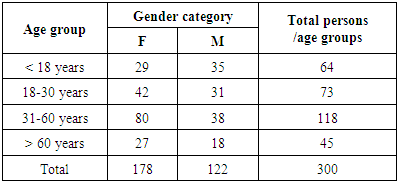-
Paper Information
- Previous Paper
- Paper Submission
-
Journal Information
- About This Journal
- Editorial Board
- Current Issue
- Archive
- Author Guidelines
- Contact Us
Public Health Research
p-ISSN: 2167-7263 e-ISSN: 2167-7247
2015; 5(5): 166-169
doi:10.5923/j.phr.20150505.07
Vitamins in Daily Life
1Faculty of Medicine, Transilvania University of Brasov, Brasov, Romania
2General Practitioner, Brasov, Romania
Correspondence to: Mihaela Badea, Faculty of Medicine, Transilvania University of Brasov, Brasov, Romania.
| Email: |  |
Copyright © 2015 Scientific & Academic Publishing. All Rights Reserved.
Healthy food consists mainly of micronutrients, macronutrients and water. Macronutrients include carbohydrates, fats and proteins, and micronutrients are consisted of vitamins and minerals. These are important factors for optimal functioning of the human body. We analyzed 300 subjects from Brasov city (Romania) concerning their knowledge about the effects and consumption of vitamin supplements. Subjects were asked about use of vitamin supplements, the season in which they normally use them, products used, post-dose benefits and consumption in the future of vitamin supplements. We also present a list of mostly consumed vegetables and fruits. For different reasons, many people do not use the recommended daily intake of certain essential micronutrients. Nutritional supplements need to fill their deficit when the daily demand is not ensured through a balanced diet.
Keywords: Vitamins, Nutrition, Healthy diet
Cite this paper: Mihaela Badea, Carmen Badea, Vitamins in Daily Life, Public Health Research, Vol. 5 No. 5, 2015, pp. 166-169. doi: 10.5923/j.phr.20150505.07.
1. Introduction
- Nutrition has become a big concern for many people in the last few years [1]. Intake of foods and food supplements for maintaining the health, for normal growth and development of children [2], in case of an increasingly urbanized population has become more and more important [3].The quality of food and food supplements are important for animal and human health [4-7]. The benefits of plant food supplements [8-10] and vitamin supplementation [11-14] are indicated in recent studies, due to the increasing importance of this topic in daily life.The role of vitamin D is important, but the quality and form that is on the market is not completely regulated in each country [15]. Research groups from UK, Canada and USA have analyzed media (print articles from elite newspapers) coverage of vitamin D in relation to its role in health and the need for supplements [16]. An international Network of Excellence EURRECA (The EUR opean micronutrient RE Commendations Aligned) explored an approach for setting micronutrient recommendations, which would address the variation in recommendations across Europe. The research groups developed the methodology framework for deriving and using micronutrient Dietary Reference Values (DRVs) (folate, iodine, iron, selenium, vitamin B12, vitamin D, and zinc) [17].Other European study [18] provided an overview of the characteristics and usage patterns of plant food supplements (PFS) consumers in six European countries (UK, Romania, Italy, Finland, Germany and Spain). Data on PFS usage were collected in a cross-sectional, retrospective survey of PFS consumers using a bespoke frequency of PFS usage questionnaire. In order to ensure the effective functioning of the EU internal market, providing as well as a high level of consumer protection, Regulation 1925/2006 [19] harmonizes data concerning the addition of vitamins and minerals and of certain other substances in foods. In this document a list of vitamins and minerals and a list of the sources of vitamins and minerals which may be added to foods were indicated. Regulation 1925/2006 has been aligned with the new Regulatory Committee procedure with Scrutiny by Regulation (EC) 108/2008 [20]. Vitamin and mineral substances may be considered for inclusion in the lists following the evaluation of an appropriate scientific dossier concerning the safety and bioavailability of the individual substance by the European Food Safety Authority (EFSA) [21].In Romania, the Ministry of Health, issued a legislative document regarding food supplements in Romania in 2000. It is authorized to deal with notifications of food supplements whose ingredients are exclusively synthetic nutrients such as vitamins and minerals [22].Because of the importance of this topic, this paper intended to determine the level of knowledge of Romanian people about vitamins (sources, role, period of consumption), as well as the top vegetables and fruits consumed by our tested group.
2. Materials and Methods
- This study regarding the intake of vitamin supplements was performed using participants that came as patients or for routine check-up to a family physician from Brasov (Romania) in the period of February-April 2011. Each second patient who entered in the physician’s office was asked to fill a questionnaire with suggested answers. For people with less than 18 years old, the parents were asked to complete the questionnaire. It was not necessary to indicate the name and address of the participants, so their privacy and personal rights were respected, according with the ethical rules of an interview. Each participant received a specific number in the data collection, in order to be easier to correlate different answers.
3. Results and Discussions
- From the 300 patients surveyed, 59% were female, 41% male, most of them were women aged 31-60 and fewest were men over 60, according to Table 1.
|
|
|
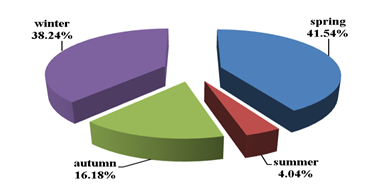 | Figure 1. The consumption of vitamin supplements on different seasons |
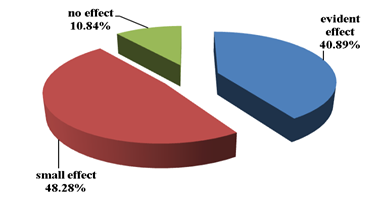 | Figure 2. Effect after administration of vitamin supplements |
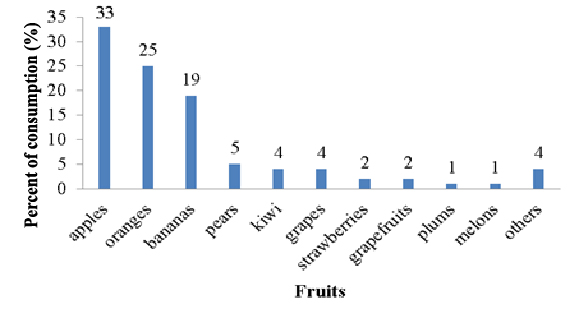 | Figure 3. Top favorite fruits |
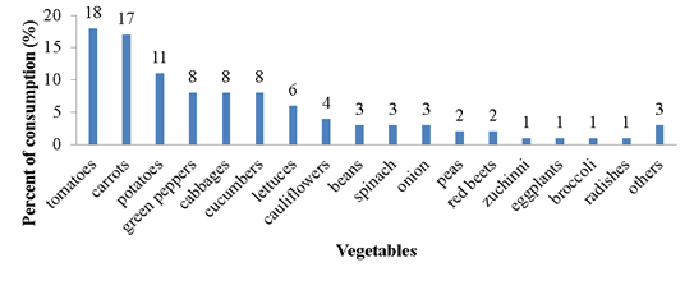 | Figure 4. Top favorite vegetables |
4. Conclusions
- For maintaining a good health, the education of the population for a balanced intake of vitamin supplements is essential. The role of mass media and family physician is very important to increase the level of knowledge of population concerning the relation between healthy nutrition and public health.
 Abstract
Abstract Reference
Reference Full-Text PDF
Full-Text PDF Full-text HTML
Full-text HTML